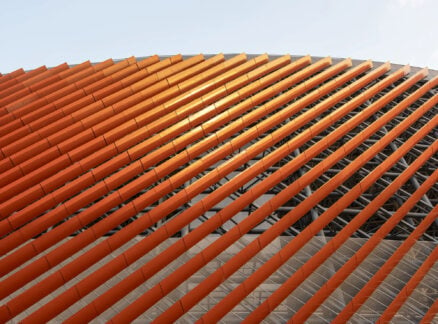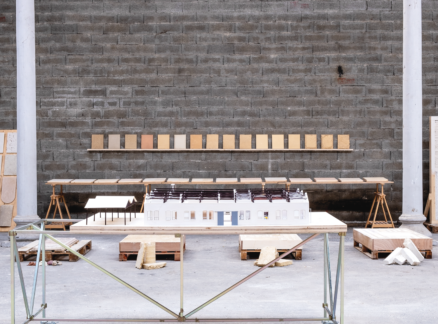
October 19, 2020
From the Metropolis Archives: 18 Insights From the Italian Master, Enzo Mari
The legendary Italian designer—a man of fiery polemics and rigorously pure forms—died on October 19. A piece from our archives explores his legacy.
“From the Metropolis Archives” republishes old Metropolis print articles not available anywhere else on the web. (See the inaugural post here.) Here we present Martin Pederson’s March 2009 article about the designer who passed away today at the age of 88. The article presents 18 insights offered by the polemical designer on the occasion of a retrospective: Enzo Mari—The Art of Design, held at the Galleria Civica d’Arte Moderna e Comtemporanea, in Turin, Italy.

Enzo Mari is a man of many fierce, incendiary proclamations. His favorite, of course, is “Design is dead.” He enjoys saying it as least once every interview. One of the last of the old Italian masters, Mari has always been an intellectual provocateur, prone to long rambling ruminations on art and design that vacillate between genuine brilliance and philosophical hot air (perhaps it’s the translation). His career began in the late 1950s, a generation behind Achille Castiglioni and Ettore Sottsass, and it’s remarkable for its output, variety, and influence. The 76-year-old seems to have designed everything but buildings (unlike Castiglioni and Sottsass, he was not trained as an architect). A recent retrospective, Enzo Mari—The Art of Design, held at the Galleria Civica d’Arte Moderna e Comtemporanea, in Turin, Italy, merely hinted at the breadth of his work. We decided to pair quotes from the elegant exhibition catalog (from interviews by Francesca Giacomelli) with samples of his seminal work, coupling the purity of his insights with the rigor of his lines. Today Mari’s no-frills aesthetic is not only a tonic for uncertain times but a stunning rebuke of his most famous proclamation. His is an enduring legacy. Design is dead, long live Enzo Mari!

On Process
This search for what is essential is still today my first thought when designing a product.
On Necessity
I am convinced that the low cost constitutes a safe perimeter for the quality of the design, if for no other reason because it forces the designer to eliminate any foolish ideas he might get: the solution of the form cannot be anything but necessary.
On Enduring
In order for a product to be continually renewed, it must be continually provided with different masks. These, as such, can only encrust a product with the overlapping of a thousand signs taken from the catalogue of universal formalism.
On Exhibition Design
When a group of objects has within it a formal quality that is the reason for their display, this must not be the justification for displays that tritely repeat the poetics of the object, or for pseudo-poetical contradiction, where what is displayed is the display itself and not the object to be displayed.

On Retrospectives
I am aware of the fact that I am like an affectionate mother with many children who might feel more love for the weakest of them. I preferred to entrust the selection of the works to a group of about twenty friends who love design, that I invited to express themselves each time solely on the basis of that which had moved them.
On Form
Form is everything. It is form that leads me to investigate, and understand, ideological and political drives.
On Formalism
The market for “design” survives on formalism. A few words on formalism. There are two kinds: that which is acknowledged and declared, and that which derives from total ignorance.
On Solving Your Own Technical Problems
If the purpose is the quality of the form, it can be no other way. Otherwise, it is just formalism.On “Design Products”
The “design” product is substantially artisanal even if such products imply the use of costly industrial equipment. But while, as in the case of the coffee cup, these costs do not influence the final cost because of the number of cups produced, in the case of the “design” product the quantity of products that can be sold is unpredictable, minimal or at times zero. It is for this reason that they need to look in the direction of an elitist market.

On Toy Design
The shapes of toys must be based on archetypal images, and these images must be realized with the highest possible quality and not in the style of “children’s drawings.”
On Quality
The quality of form emerges regardless of the trite reasons that lie behind technique and the market, that nowadays are always influenced by the rapid transformation of ties between production, methods and what is in style.
On Collaboration
Each time I have spoken to master artisans I have done so in an attempt to design a coherence with their knowledge and at times intervening to improve it. I do the same thing with workers, but with the artisan, even if he does understand, it’s different. He might own a small shop in which to work independently, if he does not, his boss might himself be an artisan. Therefore, the premises that will allow me to transmit my knowledge of form exist. But, nearly always, because we are talking about an artistic craftsman, his references are strongly influenced by the “silly things” picked up in art institutes, and this involves the difficult task of getting rid of them.
On Quality
The quality of form emerges regardless of the trite reasons that lie behind technique and the market, that nowadays are always influenced by the rapid transformation of ties between production, methods and what is in style.

On Design Education
During the first month, my professor of painting, followed by one who taught sculpture, and then the one who taught decoration, all suggested that I chose a different course of study: I asked too many questions and was never happy with the answers I got. So I ended up taking a stage design course, and fell in love with perspective and stagecraft. On my own, I wrote a paper that I called “27 ways to plant nails.”
On Process (part II)
Like every other intellectual activity in history, [a project] can only come about by negation. I negate all that which seems to be but is not. I could continue to do so endlessly, but a project must have an outcome.
On Play
When a child is growing up, [play] is the activity needed to discover one’s potential and to learn about the world. For this reason, objects used to play with are soon abandoned by children, who go on to other things, once an experience has ended.
On Shaping Atollo
A sheet of PVC is placed in a wooden mold; hot compressed air then pushes it up against the mold so that it takes on the same shape. But the sheet has to be perforated beforehand. A rubber sheet is placed between the PVC and the mold (this is the inventive part), allowing the compressed air to produce the shape.
On Emotion
When the quality of form emerges, it goes straight to your heart. It has no need for justification.
You may also enjoy “OMA Doesn’t Mince Symbols at the New Axel Springer Campus.”
Would you like to comment on this article? Send your thoughts to: [email protected]
Register here for Metropolis Webinars
Connect with experts and design leaders on the most important conversations of the day.
Recent Viewpoints
Viewpoints
Sustainability News Updates for Q2 2025











